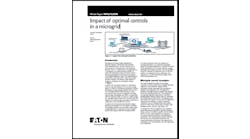Microgrids Made Easier — and Smarter — with Software that uses Artificial Intelligence
Good things don’t always come easily. Microgrids are no exception.
“The process of developing microgrids can be costly. It begins with a feasibility study reaching hundreds of thousands of dollars, even before any design, procurement and installation,” said Kay Aikin, CEO of US-based Introspective Systems.”Moreover, those feasibility studies are filled with disclaimers, and closing the gaps of uncertainty is crucial. Microgrid designs are unique, and therefore it is difficult to scale up the process of those studies without the use of technology.”
Fortunately, artificial intelligence (AI) and machine learning (ML) can help. Aikin’s company, along with Israel-basesd Brightmerge, are incorporating both into a microgrid software platform that determines microgrid feasibility and creates optimal design specs and operational controls.
The partners have several pilot projects underway with the goal of bringing the software platform to alpha stage in the second quarter of 2020 and rolling out production systems in 2021.
One pilot project is moving forward faster — a solar-plus-storage microgrid on Maine’s Isle au Haut that’s due to break ground soon. “We’ll build the system over the next 2-1/2 months with the aim of having it up and running by mid-November,” Aikin said in an interview. The island is served by an aging undersea cable connected to the mainland 20 years past its useful life that could fail at any time.
Transactive energy and microgrids
The Introspective Systems-Brightmerge microgrid software development project is governed under a contract Introspective Systems recently finalized with the Israel-U.S. Binational Industrial Research and Development (BIRD) Foundation. Its unit, BIRD Energy, has been awarding grant funding for projects proposed jointly by US and Israeli companies since November 2009.
Brightmerge and Introspective Systems won a grant in December 2018 to develop and test dynamic grid pricing with edge load responsive device control. The grant was part of $6 million in funding BIRD Energy awarded to seven projects to be carried out jointly by Israeli and US organizations.
“People use AI and machine learning in very broad terms,” Aikin said. “What we have is software based on two components that we’re building here. The first is [microgrid] modeling, simulation and optimization software that uses AI and ML techniques to better optimize the mix of assets that will provide the greatest value to customers. The other part of the integrated ecosystem we’re building is feasibility analysis software that extends all the way to microgrid controls.”
“Then there’s the transactive energy control system, which is sort of our secret sauce…” — Kay Aikin
The feasibility study engine carries out a process that improves the speed and results of evaluating microgrid projects that may be presented to developers and determines whether they should pursue it or not, Aikin explained. Second, the design optimization engine considers all the assets and variables associated with a specific microgrid project to design an optimal mix of assets.
“Then there’s the transactive energy control system, which is sort of our secret sauce, which we’ve started to deploy in Maine,” Aikin said.
The transactive energy control system uses AI and ML to maximize a microgrid’s decision-making and control at all times, making use of market prices as a sort of base signal. The real time control software aggregates the data and information collected by independent software agents that work for their own purposes with the overall goal of creating value for the customer, Aikin said.
“Transactive energy makes use of market-based approaches, sending real time pricing to edge devices. A device may then decide whether or not it’s worthwhile to turn on a heating system given the need to maintain the temperature in a room or house at a certain level, for example,” Aikin said.
The value of a high-performance supercapacitor
The Maine microgrid pilot will use a high-performance supercapacitor designed and built by New York-based Kilowatt Labs. Supercapacitors are used for high power, short duration electricity dispatch. Kilowatt Labs’ supercapacitors are different.
“It’s a very unique battery, a supercapacitor actually. They’re using very innovative software to transfer power from supercapacitor cells that are fully charged to those that are empty or low very rapidly,” Aikin said.
Constantly cycling charge so as to keep the entire system fully charged enables the supercapacitor system to dispatch power over long durations, as long as 12-14 hours, according to Aikin.
In addition, Kilowatt Labs’ supercapacitors have much longer life cycles than lithium-ion batteries, cost much less to operate and maintain. They’re based on well known and proven design and engineering and make use of simple, standard materials that don’t come with the safety risks of lithium-ion batteries. And they’re modular and scalable, Aikin said. Those attributes could prove very attractive to microgrid project developers and their customers.
“They actually have the same characteristics as any other energy storage device, such as lithium-ion and the various flow batteries. One of the advantages of the Kilowatt Labs storage is that the charge-discharge rate and storage duration are decoupled. So in a lithium-ion battery you have a 1:1 or 1:2 or 1:4 power-energy ratio designed into the base system. Kilowatt Lab’s systems can be tuned to the application. So for Isle Haut, the initial system has a 1:4.2 ratio. When we expand the energy storage, it will be a 1:8.4 ratio. This could be further expanded in the future if conditions warranted. You could not do this with any other storage system,” Aikin said.
An initial 500-kWh Kilowatt Labs’ battery storage system is ready for delivery and Introspective has an option on another 500-kWh system that it anticipates rolling out over the course of the next two to three years, Aikin added. “The bottom line is in Isle au Haut under most conditions we will be holding 12-14 hours of charge and discharging that overnight. That will allow the overall system to be around 92% renewable,” she said.
Track news about microgrids. Subscribe to the free Microgrid Knowledge newsletter.







